In a recent webinar hosted by Oracle, Reggie Bradford, 3x Entrepreneur and Senior Vice President, Startup Ecosystem & Accelerator at Oracle, chats with SaaStr’s own Jason Lemkin about how to maintain the enthusiasm and pace of a startup when you aren’t a startup anymore.
Here’s a hint: it takes more than bean bag chairs and free food. You have to start making changes that will set the business up for continued growth, whether that be hiring VPs to take on some of the work or integrating the back-end systems to facilitate coordination. Most importantly, share with employees so they have something to look forward to and be proud of as well.
We have the transcript of the informative discussion below and you can watch a replay of the webinar here.
Transcript
Reggie Bradford: Welcome and thank you for joining us today for the webinar “Five Biggest Challenges for SMBs, Identifying Your Weaknesses and How to Overcome Them.” Before we get started, just a quick reminder that this is the third of a four part webinar series.
We completed the first and second in January and March. We have one more coming in May. I hope you can all join us for the last one. Of course, you’ll be able to access all the webinars online.
I’m your host, Reggie Bradford. I’m SVP Startup Ecosystem & Accelerator at Oracle, helping to lead our crowd transformation as well as our global startup and innovation initiatives, including the start of cloud accelerator programs.
Just a bit about me. I’m an entrepreneur as well. Oracle bought my last startup, Vitrue, back in 2012. I had two startups prior to that, N2 Broadband, that was acquired in 2005 by Tandberg and then WebMD, way back in the heyday of the late ’90s.
I’m absolutely fired up to be joined today by fellow entrepreneur Jason Lemkin, of SaaStr fame. For those of you who don’t know, which probably is nobody, given your meteoric success Jason, can you tell us a little bit about yourself?
Jason Lemkin: Absolutely. I’m a recovering two time founder, just like you Reggie. My last startup, a company called EchoSign, which was a pioneer in the electronic signature space, I sold to Adobe way back in 2011, just as we crossed a million a month in revenue. It was a fascinating time to sell, just as things actually got great. I just didn’t know it.
After I finished my tour of duty at Adobe, I started sharing all of my mistakes and learnings. Fast forward today, the SaaStr community gets about three million views on its content. We had 10,000 folks at our global confab, the SaaStr annual, this year, which Oracle was a part of, which was terrific.
We’ll have over 20,000 next year. All this is about is just helping founders scale and do better than I did, do better than you did, do better than we all did. Once you know the playbook, you can make fewer mistakes.
Reggie: Absolutely. I love it. Thanks for coming on. It’s a pleasure to have you. Today we’re going to talk about how to best position the SMB for growth, with a little bit of a twist. At the last webinar, we talked about the most important foundational pieces for small businesses to ensure survival.
Many business, there comes a time when they’re no longer startups but still not fully established. That’s a critical point, maybe calling that scale or whatever you want to call it. We’ll tackle this by addressing five areas, the individual relational strategic ecosystem in technology.
At Oracle, we have a new SMB study coming out next week which we did in partnership with “Inc. Magazine,” but I’ll share a few steps today as it is relevant to what we’re going to be talking about.
First, 9 out 10 respondents in the study described themselves as either extremely confident or very confident about their prospects for the future, which is good news.
Backed by this confidence, the majority, 91 percent, planned to expand their workforce, 61 percent to offer new products, 65 percent to move into new markets, and 32 percent to do more business internationally in the next year, so clearly a lot of optimism.
Before we get started, and to help frame the conversation, I just picked a few of the quotes. Note that the 50 percent stat on startup failure is actually higher, almost 90 percent according to my experience.
As your business enters and exits these different phases from startup to expansion to maturity, it’s going to face obviously, challenges. We both faced that, Jason and I, at every stage.
At each stage, it’s crucial to make the best decisions in order to identify the key business issues, manage through them, and maintain strong momentum and keep the train on the track.
First, let’s talk about the individual concerns. Most startups operate with an all hands on deck mentality. If something needs to be done, everyone jumps in to help, but as your business grows it has to change, and it starts with individuals, namely you.
Talking about passion and drive, in the early days, your passion or drive may have been the only thing keeping you going. For some, it may have been ego or fear of failure. As that enthusiasm fades, you become bogged down by the process and red tape. You may need to evaluate the situation to determine what will motivate you to keep going.
Although this is true for all employees, and especially true for founders, partners, executives, we can almost title this “Know Thyself” because it’s really about being honest with yourself. I know in my experience, my most recent startup I was the sole founder, which was frankly very lonely.
It was very challenging with the ups and downs, business getting away from me, almost going under a few times, this and that. Jason, I want to start right here and jump in, and maybe just talk a little about what you’ve seen or personally experienced.
Jason: That solo founder story is interesting. The question here really is, once you’ve actually gotten something off the ground, which is impossible, right then and there, how you carry that. The real challenge you need to ask yourself is are the founders and the initial folks aligned together.
The hardest part coming out of these early days is, if you don’t really nail that initial team or founding team, a bunch of them may not be committed for 7 to 10 years. This stuff is hard. [laughs] There’s nothing like founder or CEO stress. There’s nothing like it on the planet.
Folks that haven’t been CEOs or founders don’t get it. VP is hard, man. It’s hard. It’s hard to be a manager. It’s hard to be a rock star engineer, but there’s nothing like founder or CEO. The truth is, people that do this are not committed to 7 to 10 years.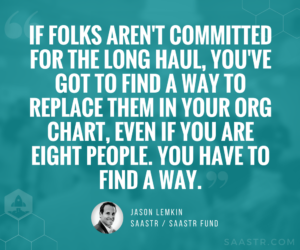
The most important thing is to have an honest dialogue. If folks aren’t committed for the long haul, you’ve got to find a way to replace them in your org chart, even if you are eight people. You have to find a way.
Reggie: I couldn’t agree more Jason. The best advice I got was from an early VC, about 15 years ago. He said the biggest mistakes startups make is they underprice their products and they hold on to poor performers too long. I think the second point is exactly what you’re saying. I don’t know…
Jason: The reason why is like… sorry, go ahead Reggie.
Reggie: No, no. no. Go ahead.
Jason: I think there are two tests that I do here. For people doing something that’s early, I do this little entrepreneur talk at Stanford Business School each year, with the most enthusiastic business school students.
Everyone has already built a paper startup or something in this class. I ask them this one question. They hate me for it. I’m surprised they ask me back. This is at Stanford Business School. They have resources. They have more than you and I had probably had in the beginning.
I say, “Who’s committed for the next 24 months, with no salary, with no anything, no matter what, to make this a success?” Usually there are three hands.
Reggie: [laughs] I bet.
Jason: They’re all, “I’m giving it 8 months. I’m giving it 12 months. I’ve budgeted 6 months.” If you can’t get from zero to whatever, to viability, if you don’t budget for 24 months, your odds of success are close to zero. That’s a thought for both yourself, as an individual and your colleagues and co founders.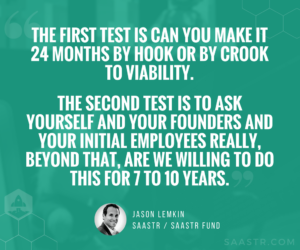
Can you guys go 24 months before you can feed yourself, before you have happy customers? Most folks do not have the tolerance for that. It doesn’t make you a bad person. It does mean you’re going to fail. The first test is can you make it 24 months by hook or by crook to viability.
The second test is to ask yourself and your founders and your initial employees really, beyond that, are we willing to do this for 7 to 10 years. If you’re not willing to do it for 7 to 10 years, you’ll finally get that smidge of success and then you’ll implode from the stress from the next phase.
These are my tests. 24 months and 7 to 10 years. If you and your initial founders and colleagues aren’t aligned on 24 and 7 to 10 years, sometimes my advice is take a pause and reboot the team.
Reggie: I’ve done that a few times too. I love it. That’s good stuff. You’re talking also about time management. That’s the second point here I just want to touch on. At this stage, you’re going to be making the most effective use of your time as possible.
Time is the biggest currency of every founder, every company, all of us, frankly. Ignoring, just for a few minutes, the business side of it, you personally need to make sure you’re not going to burn out. If you’re making ineffective use of your time, you may find yourself with very real problems that impact business, your emotion, family and health.
My own point of view on this, and I think I read it in Stephen Covey’s 7 Habits or whatever, is you have this emotional bank account. You make withdrawals and you make deposits. I always had to lay this out with my wife ahead of time.
I’m going to start this new company. I’m going to be making withdrawals. I’m going to be traveling, but I’ve made a substantial number of deposits. The point is that it’s 24/7, 365. Jason, I know you coach businesses through this stage. What advice do you give the guys you’re involved with and founders and leaders and stuff?
Jason: Two thoughts related to two different points you made in that one point. Let’s go back for a minute. On time management, tactically, a lot of us, as founders, or executives, or whatever, think we’re bad at time management.
I think we’re actually great at it. Our guts tell us exactly what the most important thing is to do today, this week and this month. We know. Reggie, you’re traveling the globe. You have a huge portfolio of responsibility, but you know exactly what the two most important things you have to do are.
The challenge is 4 through 400 on the list. That’s where we fall apart. What do you do about that? If you transition to being overwhelmed with time management, as a CEO, founder or VP, the problem is you’ve failed at recruiting under you.
You have to build management under you. If you’re a CEO, you have to build the VPs under you. If you’re a VP, you have to build the directors under you so that you can manage your time. If you are overwhelmed, take a pause and do nothing literally but recruit.
Recruit at least one person that will solve this problem for you. You cannot solve it yourself. You’re doing too many things. That’s the root cause.
[crosstalk]
Reggie: Yeah, absolutely. When I was at Vitrue, people knew. I left the office at 5:30. I tried to everyday, so I could be home with the family. That was all about hiring an incredible, quality management.
Jason: Yes. As soon as you feel like you can’t manage your time, stop what you’re doing. Even miss the month. Even miss the sales plan and hire that VP. Even in my little SaaStr organization, just to do our event next year, we have a $12 million budget. I’ve actually had to drop almost everything just to hire my own VP of marketing.
I dropped everything on my schedule to make this hire, because I own too many things. I’m looking at the third time. It’s not any easier the third time. Let me just talk about one other hard thing on this topic of time management.
The “simple” thing and I’ve put simple in quotes, is to do what you and I did, Reggie, which is hire that VP, hire that manager for 4 through 400. Don’t be a VP yourself any longer than you have to, if you’re CEO. Hire the VP. Don’t be a VP forever. Don’t be a VP after $2 million revenue.
You talked about going home at 5:30 to your family and you talked about burnout. One thing I do want to advise folks and this is a horrible thing, if you want to build a hyper growth company, if you want to do the crazy kind of things, if you want to build the next Oracle, I don’t think there is any balance.
Even if you go home at 5:30 each night and have dinner and tuck in the kids, you will never for a moment of any day in your entire life stop thinking about your company ever. Ever. You will think about it in the shower. You will think about it when you’re running. You will think about it on vacation. [laughs]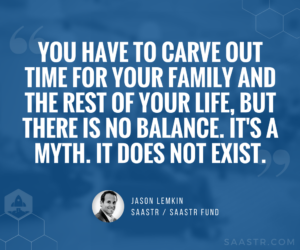
Unfortunately, the balance does not exist. What you do have to do is carve out time for your family and the rest of your life, but there is no balance. It’s a myth. It does not exist.
Reggie: I think that’s a fair point. That gives us a good leeway to go into our next topic, which is relational. We talked about this already, a little bit, when it’s time to evaluate the organization and the people in it.
Leadership and talent we have here, beyond a great product, strong marketing, and sufficient capital, businesses thrive or fizzle based upon their people. This is a couple fold. Not only do you need to be making sure you’re offering great leadership.
Also, it’s critical you surround yourself with other great leaders. One of my favorite books of all time is Good to Great, by Jim Collins, talking about why some companies make the leap and others don’t. His point was great vision without great people is irrelevant.
I think he also talks about getting the right people on the bus, I seem to recall. Again, we talked about this. Our company is a little bit of an example. Jason, I know you’ve spoken extensively about this, when it’s appropriate to bring in new talent, all the way from executives to salespeople. You touched on it a little bit earlier. Do you have one or two pieces of additional advice on this?
Jason: Sure. Maybe just one or two. These are mistakes that we all make again and again. The first advice is pay up. It’s hard to build something when there’s no cash and there’s no money. As we build out our leadership teams, the mistake many of us make, especially first time founders, is we err on saving a few nickels on management.
A great VP may be 50 percent more than a good director. A good director may be 40 percent more than a manager. What guys like you and I that have done it Reggie, do know is not just that great talent is important. It’s that great talent is accretive. It’s accretive.
A mediocre director at 80 K may be a cost center, but an amazing VP at 160, at twice the price, may bring in a half million of revenue. [laughs]
Reggie: Yeah.
Jason: Overpaying for mediocre talent is the sucker bet, but don’t save nickels. It will only accrete up higher. Save nickels on fungible hires. Save nickels on things that are fungible. Everyone makes this mistake of going more junior to save money, or to save stress.
Don’t do that. Challenge these better hires to be accretive. Force them to have a plan and a KPI, where they pay for themselves. Then you’ll know if they’re great. So, pay up. [laughs]
Reggie: I’ve also made the mistake of overpaying for underperformance, but that’s another story. [laughs] I couldn’t agree more.
Jason: The related advice is, when you do finally get that confidence to pay up, the flip side is don’t fall for logos. As we are learning, we always want to hire someone from Oracle or from Box or from whatever the latest company is that we all have heard of. It was MuleSoft IPO the other day. Maybe it’s Snapchat for some of you.
We’re all looking for that domain expertise that we don’t have, that experience. Sometimes the better the logo, the less experience they have, because there’s so much infrastructure to help these people. If you haven’t done it, don’t fall for the logo on the LinkedIn. Challenge yourself.
I’d much rather hire someone from the number two or the number three unit space that had to do it for real than someone that was handed all the benefits of a brand.
Reggie: Absolutely. I could not agree more. I have this team sports mentality. I’d rather draft for athlete than skill position. It’s a similar philosophy. I’ve seen exactly what you’re talking about. Let’s shift to “culture” real quick, a little bit of a buzzword.
We have it in quotes, because it’s hard to define and, therefore, hard to establish or change. It’s so vital to a company’s identity and brand and strategy. At this stage of growth, beanbag chairs and free food probably aren’t what you’re going for.
Recognize the steps you take now will define what the business ultimately becomes. Don’t neglect this area. All you have to do is read the news and see an almost daily reminder of how company culture can impact business.
Our friends at Uber most recently offered a negative example, but there’s some great positive ones as well. TOMS is very famous for their terrible mantra “One for One.” That is, in fact, for not only who buys their product, but who applies, who’s hired.
Also, a company I’m very involved with, Cherry Water, has a very similar amazing culture. If it helps, you could think of this as an aspect of talent management. If you create a culture that attracts and retains talent, you want me, you’ll save thousands, maybe millions on HR.
Jason, have you seen any notable examples of this you can share and talk about your view on the importance of culture for businesses?
Jason: I’ll tell you one. I’ve thought a lot about this in light of a lot of the challenges we’ve seen in the press and the media from hyper growth companies, their challenges with culture and what I’ve learned.
Culture’s a weird thing. We’ve all, maybe not all of us, Reggie, at least you and I have worked probably for other companies where foosball tables and fancy waters in bottles were seen as culture or going out for paint ball expeditions.
I worked at terrible companies that did the most paintball, cupcake making, pottery making activities and that never created a great culture. I feel culture is people. Let me step back for a minute. Here’s what matters in culture. How do you invest in culture?
In the very early stages of the company, culture is not anything because culture is the CEO and the management team. It’s nothing else. If it’s a company of six, it doesn’t matter how cool the office is or what you do. The culture is the CEO and what she or he drives the company to be with his or her cause.
What does change later is probably when you’re around 50 employees. This is not the CEO’s company anymore, is it? [laughs] You can’t interview all the people. As you cross 100, you don’t necessarily even know all the people that join your company.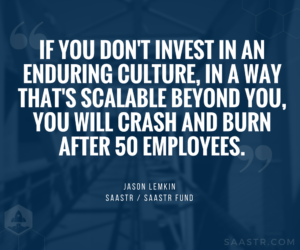
The real issue is, if you don’t invest in an enduring culture, whether it’s One for One like TOMS that you talked about, if you don’t do these things somehow in a way that’s scalable beyond you, you will crash and burn after 50 employees.
My hack here, my hack is not to try and copy other companies, per say. Here’s my hack for the CEOs out there. Be the CEO that you need to be in two years. Be the CEO of 2019. I don’t work at Uber. When I watch the challenges that Uber’s having today, Uber is acting like the Uber of 2015 and not like the Uber of 2019.
Not like an iconic public company that has a responsibility to the entire new universe. Uber’s acting like a little bit of a frat house startup even today. We could debate whether that was OK 2015. I don’t think it’s successful in 2015, but it’s definitely not OK in 2019.
[laughter]
Jason: If you carry yourself as the CEO of 2019, you’ll make many of the right decisions to scale your culture.
Reggie: Very good. Let’s talk about for most companies the most important thing of all, product and selling. You’ve got an actual product or service. Everyone is selling something. Otherwise, they wouldn’t be in business.
We have this little term “chess versus roulette,” which almost goes without saying. Time and time again, companies fail or they grow faster than they can sell or they promise what isn’t quite creative enough. I’ve been accused of that as well.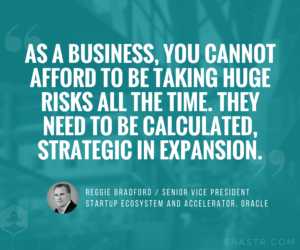
Even if chess versus roulette sounds like a strange title, it really encapsulates the idea. There, as a business, you cannot afford to be taking huge risks all the time. They need to be calculated, strategic in expansion.
The root of that is your sales focus is critical here. We talk about this all the time, “The Innovator’s Dilemma” and focus, focus, focus. Jason, I’m sure you’ve seen both good and bad examples of this. Can you talk a little about some that stick out?
Jason: One thing everyone should think about, because we get a ton of advice in this stage, growing faster than they can sell, all these issues. The challenge we get is that there are really two types of company models.
Does headcount grow revenue or does revenue drive headcount? Here are the mistakes we make. Once you have a real engine, once you’re at Oracle’s size, you have a funnel. You know exactly what pipeline is. You know pipeline to quota ratios.
When you have a quota to hit this amount of revenue at a successful bigger company, it’s all headcount driven. You have a quota of $50 million this year and it’s a million dollar quota per rep. If I don’t have 50 sale reps, I don’t make the plan, right?
Reggie: Mm hmm.
Jason: Great executives of large organizations all know that headcount drives revenue. The problem with startups is it can take a while for that to be true, if it’s ever true. In startups, we have to be more careful that revenue drives headcount.
If I want to hit $4 million in revenue this year, maybe I need to hire in arrears. Do I hire in advance in arrears? I guess my uber advice is be careful that you make sure that heads drive revenue because it’s a winding path in the early days.
Don’t fall into a trap that putting boots in the field or putting rears in the desk automatically drives revenue. Leads drive revenue. Leads drive revenue for most of our reps, not heads.
Reggie: Absolutely.
Jason: Get the leads up, and then staff them with the minimum headcount you need to crush it.
Reggie: I always like headcount as a lagging…I was always tight fisted. At the same time, it’s a huge point. Innovation is the other part of this one to touch on really quick. I know it’s a buzz word, but let me explain what I’m talking about here.
No company would have gotten to this point, anybody here on the call, without at least one good idea. The question becomes, “How can you survive on past ideas?” At some point, you need to start coming up with new ones, even if they’re small ones.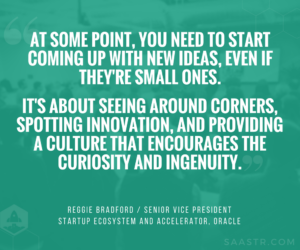
It’s about seeing around corners, spotting innovation, and providing a culture that encourages the curiosity and ingenuity. Many examples, I just read an article, in fact, I was with some of the Unilever folks this morning, in “Entrepreneur” magazine about Michael Dubin, the founder of Dollar Shave Club and his company’s meteoric growth.
In five years, he turned a warehouse of surplus razors into an industry changing phenomenon. Sold to Unilever for a cool billion dollars, which some are saying was a great, very strategic acquisition by Unilever to get into a direct business to consumer marketplace. Jason, innovation is another area where you’ve got some really good insights.
Can you tell us when, in your experience, companies need to begin innovating and how SMBs and many people in the audience that are not necessarily tech companies, but any business can keep their eye on the next innovation waves without distracting or steering off course of the core business that they’re in?
Jason: Sure. There’s one exercise I like to do. Everyone has competition. The smaller you are, the bigger and the better resources and the scarier your competitors are. We have a hard time pointing to too many companies that were the very first to do what they do, right? [laughs]
Reggie: Mm hmm.
Jason: I guess Oracle was probably the first relational database back in the day, but it wasn’t the first database.
[laughter]
Jason: We take an extreme example on the call. I like to do a “Keep Ourselves Honest” exercise of 10x better. I like to get the management teams together once a quarter when we talk about product and be honest. List the things today we’re 10x better than the rest of the world on and where we want that to be next year.
It’s a tactical exercise as well as strategic, but you can win in any marketplace even with a very feature poor and even mediocre product, if you do one thing that is saleable. One thing that people will buy that is 10 times better than anyone else. That’s how you get off the ground.
The trap we get into as we scale is we get so focused on short term competition, so focused on why we lost the deal last week, that we don’t talk about 10x anymore and we talk about 1.1x too much.
Reggie: Very good.
Jason: If you can’t answer that question, you’ve got to make some changes.
Reggie: Good transition, Jason. You actually brought up ecosystem. Let’s talk about that. Starting with data and KPI, businesses most constantly follow the data both within their businesses as well as the marketplace. Obviously, being a data driven company is essential.
Whether you’re a pizza shop or Google, everybody has to use data to make decisions. It’s not just a buzzword. It must be put into practice and part of the company’s DNA. Around data and KPIs, Jason, maybe you can riff on what your opinion is the best approach to data and KPIs and how can companies truly become data driven?
Jason: Sure. Let me try and simplify this because most of us actually don’t even know what a KPI is or, if we do, don’t even implement them. Let’s step back a minute and simplify KPIs to goals. I like to start with one thing. This helps with the data answer.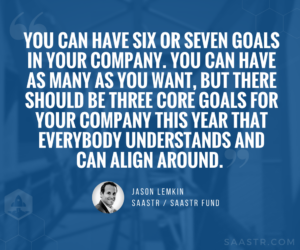
You can have six or seven goals in your company. You can have as many as you want, but there should be three core goals for your company this year that everybody understands and can align around. It can be revenue plus NPS or customer satisfaction plus a product goal in terms of releases, whatever it is, three goals for the company.
Each department, even if you’re tiny, each department: sales, marketing, engineering, product, customer success, should have at least three core goals that roll up into those three, these should be emotion free.
Every quarter, every month, every week, get your company, all hands, even if it’s ten of you, all hands, you review these goals. If you don’t have these core goals that everyone gets, if the goals are loosey goosey, you don’t really grow as quickly as you could.
I was terrible at many things as a founder, but I was pretty good at this. It works.Add this tomorrow. The beauty is, if you have three core goals that you review every week, every month, every quarter at your company, each VP does, they will start to collect and manage more data to support those goals.
If nothing else, maybe learn from data. You will seek out vendors. You will seek out solutions. You will seek out tools that help each department and the company to meet those goals. That’s my hack to KPIs and data.
Reggie: I like it, simple and straightforward. KPIs, by the way, Key Performance Indicator, is that right? You said a lot of people don’t know. I don’t know.
Jason: Yeah, or maybe just call them goals.
[laughter]
Reggie: I have goals every day.
Jason: Then the other part of this…
Jason: …measure. Goals you can actually measure.
Reggie: Absolutely. The other part real quick is the…
[crosstalk]
Jason: The goal part directly is under the KPI.
Reggie: [laughs] Everything you said today should be informed by the larger market. Not only should you be zealously scouring your own data and measuring internally, we talked about this before, but consider the big picture, what’s happening across your market competitors. Jason, how do you counsel the businesses you work with on this aspect?
Jason: Boy, for outsiders, like you and me, for any particular company, we have to be careful how much market advice we give because the folks on this call are all going to be better experts than me.
Let me give you two high level learnings. One thing we all obsess about is competition. We obsess about it. We read every tweet, every press release, every email. In fact, I would argue the only people who read press releases today are your employees and your competitors. [laughs]
I don’t think anyone else reads the press releases. The world has moved on. Let me throw out two Zen thoughts. As stressful as competition is, I will suggest to you that whatever your revenues are, if you’re growing 60 percent or more a year, your competition is not really hurting you. Not really. You may be losing deals every day.
You may kick yourself that you just lost this big deal at Oracle or wherever it is, but if you’re growing 60 percent a year, that’s always hard to do. That means you’re doing something right, and you’re winning over your competitors somewhere. You have the competitive advantage here, if you’re growing 60 percent or more a year.
Focus on doubling down on your competitive advantage rather than completely sweating about your lack in the areas where you don’t have that advantage. If you are growing slowly, I would argue competition is a root cause.
You’ve got to go back to that 10x analysis that we talked about. If you were growing less than that, I don’t think you’re better at 10x than anybody else. Use that as your true north. 60 percent or more, don’t sweat the competition so much.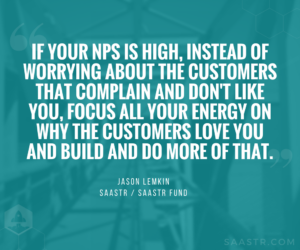
A related point is, I would say if your NPS, your net promoter score, is over 50, if your customers love you, worry less about competition. You’re doing something right. If your NPS is high, instead of worrying about the customers that complain and don’t like you, focus all your energy on why the customers love you and build and do more of that, if your NPS is high.
Focus on your promoters, not on your detractors. If your NPS is low, if you have a lot of detractors, focus on your detractors. [laughs]
Reggie: [laughs] Well stated.
Jason: We also overreact. As founders, we get so sensitive to any customer complaints. I don’t know if you did. Every time I heard any customer complain, the hair on my neck went up. If I’d realized how high my NPS and CSAT stats were, I would have focused more on the customers above me. That’s what you should do, if they do love you.
Reggie: That’s a great piece of advice. Especially now, looking back on my own career, I remember crying in an airport when I lost a deal, but that’s another story.
Jason: Yeah. You cried about that, but you should have switched your flight and gone and visited your happiest customer. [laughs]
Reggie: Exactly. Speaking of crying because of technology, let’s talk now about technology and scale. First of all, if growth is your goal, then scalable growth is the ultimate prize. You can call it smart, sustainable or whatever.
The point is it has to be real growth. The key to this, in my opinion, is taking every advantage of technology you can. Again, everybody has to use technology today. Cloud computing, AI, Internet of things, these are all becoming more important, pervasive and persistent advances that can’t be ignored.
Just a few other insights from our new Inc. survey that we’re doing together that’s coming out next week. The majority of Inc 5000 has adopted Cloud technology. Nearly 60 percent cite scalability and flexibility for growth as primary drivers of Cloud adoption.
More than 83 percent of respondents have at least two functions in the Cloud. However, just over a third have their finances in the cloud. Only 29 percent have put their eCommerce functions in the Cloud solutions. 44 percent struggle to achieve integration across their Cloud products.
Jason, I know technology is what SaaStr is all about. Give us some advice here, particularly around Cloud adoption.
Jason: Yes. I will and let me go even further. In 2017 and 2018, we are post Cloud. Everything’s in the Cloud. You should be doing everything in the Cloud. I think we’re in the everything as a service decade. That’s the next decade. Everything as a service. You should be using every platform you can. You should be using every API that is there.
Everything will become a service. Build nothing yourself. [laughs] If you think you have to build something yourself, challenge yourself and go find out, “Isn’t there a vendor like Oracle that has a product for me?” There’s almost nothing you should be building yourself today. Almost nothing.
Reggie: Makes tons of sense. Focus on your core competencies.
Jason: If you don’t think there’s a service for something, everything is a service, search harder. There may be. There is QA as a service now. There is search as a service. There is call center as a service. All the things that you and I had to build, everything exists as a service.
Look at the Twilio IPO. There is voice as a service. Build nothing. Find a service for everything. Platforms were like the first version of that, don’t build your own infrastructure. Today, you just have to take the best platform. You’d be insane to build your own text back today. I can go further, build nothing.
Reggie: I like it. The last point of the presentation is around value. I’ve got a little nugget here. As you build out the business, don’t take shortcuts, as you mentioned, with your technology, architecture and infrastructure. Don’t build anything else. I don’t think you said that. [laughs]
I’ve seen more than a few companies stymied by a hodgepodge of disparate systems. There’s definitely no reason to do that. Most of the big tech companies can offer you completely integrated world class systems through the Cloud at a very affordable price and plenty of startups as well.
Honestly, I can’t think of anything worse than being in the midst of a growth spurt only to have it halted prematurely, because your technology can’t handle the pressures of expansion. Not only that, but the sooner you invest, the cheaper it will be in the long run.
Obviously, we’re very focused on scaling them as well as obviously working with the largest enterprises, but this is about the mid market here. Any thoughts around technology Jason?
Jason: Yes. One big thought, especially for folks on this discussion that aren’t technologists. Most of us that are not technologists do not understand how to scale technology. It’s not intuitive. It’s not intuitive when your products will break. It’s not intuitive how far your current email marketing solution will scale. It’s not intuitive how far your platform will scale.
We talked about a 10x sales to marketing differential. Here’s a different 10x rule. You have to have an honest conversation about your team, without anybody being defensive, about how the heck you’re going to scale what you’re doing 10x, on the platform and technology side.
Here’s the thing that you’ll know, if your team is honest. There’s not a single software company, SaaS company that, with the current, exact stack of software it has today, can scale 10x. It does not exist. The best most of us can do is 2x, with the exact number of instances we have, with the exact tech stack, with the exact middleware.
It’s very hard to scale 10x, no matter what anybody has heard about platforms. Portions of your platform can scale 10x. Your Oracle Cloud may scale 10x. You have to identify the blockers to 10x and do it in a staged fashion, so that you’re triaging, every quarter, how you upgrade your infrastructure.
Don’t be delusional. Don’t stick your head in the ground. Don’t believe that every Cloud scales infinitely, because it’s not that simple.
Reggie: Fantastic. Thanks for that Jason. We’ve covered a lot of topics today. I wish we had more time. I know we could talk for many longer hours. Maybe give the audience some of your key takeaways. A couple of words of wisdom or nuggets or insights would be awesome.
Jason: Especially for folks that are SMBs on the call, we talked about it before, but if I had to just give one piece of advice, because this is all so hard, just one, it’s don’t settle on your key hires. Don’t settle.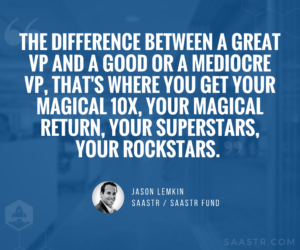
The difference between a great VP and a good or a mediocre VP, that’s where you get your magical 10x, your magical return, your superstars, your rockstars. Don’t worry about rockstar individuals. Your VPs will find them.
When we’re ready for that VP of Sales, VP of Marketing, or whatever, the reality is that nine out of ten of us will settle. We get tired. We don’t interview 30 candidates. We don’t interview 50. We don’t hire recruiters. We don’t get out of the office.
If you settle for your VPs, you’re just kicking the can down the road. It’s going to blow up on you in six months. Don’t settle.
Reggie: Very good. Excellent advice Jason. I really appreciate you taking the time to join me today. Thanks to our audience as well. Please, connect with us across all of our social channels. We’ve got all our handles and everything else here. We’d be happy to engage with you.
Another reminder about our past and upcoming webinars. I hope you can join us. Thanks again. I hope everyone has an awesome day.

